Writing view
This page explains how to use the arabic writing view of the Egyptian Arabic Dictionary. This web page will teach you how to read and write arabic.
Tabs
The page has three tabs: you can select a tab by clicking on it.- Learn Reading You should start with this tab. It displays an on-screen arabic keyboard: when you select a letter, it displays a description of the letter, shows what the letter looks like in different positions in a word, and gives several examples of words that contain the letter. You can listen to the example word, or follow a link to find out what it means.
- Practice writing This tab selects a word at random from the dictionary, then asks you to type in the word using an on-screen arabic keyboard. If you get a letter correct, it appears in green: if you pick the wrong letter, it is displayed in red.
- Options You can use this tab to specify whether the on-screen keyboard should have transliterated (european) letters, or arabic, or both. You can also set the difficulty level for the practice writing tab.
For more information about arabic writing, see the Arabic writing page.
Learn reading
The Learn reading tab initially displays an on-screen arabic keyboard that looks like this:
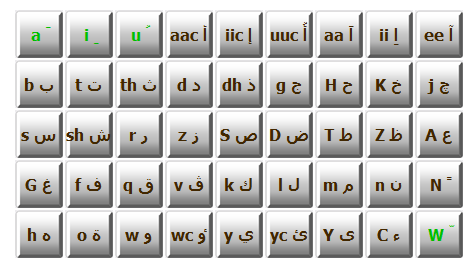
The letters are divided into ten groups of four or five letters: if you learn one group of letters every day, you will be able to read the entire alphabet after just ten days!

You can select a group using the selection box just above the keyboard: when you select a group, the letters in the group are highlighted on the keyboard.

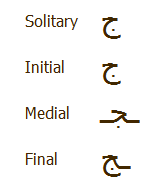
when you select a letter, it displays a description of the letter, shows what the letter looks like in different positions in a word.
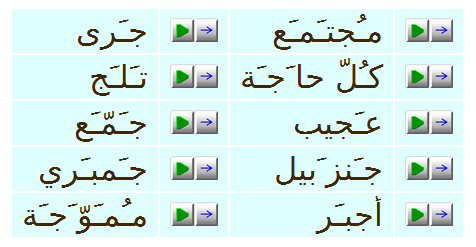
It also displays several words that contain the selected letter. If you click on
the  button, you will hear somebody saying the example word.
If you want to know what a word means, press the
button, you will hear somebody saying the example word.
If you want to know what a word means, press the  button.
button.
On the first groups, just try to recognize the selected letter in each word.
Once you have learned most of the groups, try to read each word and say it out loud,
then press the  button to see whether you were right.
button to see whether you were right.
Practice writing
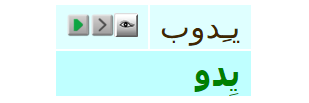
This tab randomly selects an Egyptian word, then asks you to then type in the letters using the on-screen keyboard. Initially, you can just read a letter at a time and find the letter on the keyboard: once you can find the letters, read the whole word and say it out loud, then try to type in the letters without looking at the example word.
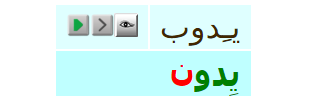
Each time you type a letter, it appears just below the original word. The letter appears in green if it's correct and red if you select the wrong letter. You can use the backspace key (bottom right of the keyboard) to remove the incorrect letter and try again. There is no button for shadda: just press the key for the repeated letter twice.
You can press the  button to hear the word.
If you want to know what a word means, press the
button to hear the word.
If you want to know what a word means, press the  button.
Remember that you are supposed to be learning to write, not learning words, so you don't need
to do this for every word!
button.
Remember that you are supposed to be learning to write, not learning words, so you don't need
to do this for every word!
You can show and hide the word automatically (see the Options tab) or manually
using the  and
and  buttons.
buttons.
If it's too easy or too difficult, go to the options tab to change the amount of help that you get.
Options
You can use this tab to select your preferences for the other two tabs.
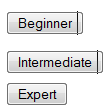
You can set the level of difficulty for the writing practice tab using the level buttons, as above.

Alternatively, you can set each of the options individually.
The on-screen arabic keyboard can have letters in european (transliterated) writing, or arabic writing, or both.
You can play the sound automatically when a new word is selected.
You can display the word all the time (easy) or have it disappear as soon as you start typing (intermediate) or not display the word at all (advanced). For the latter, you should turn on 'play sound automatically'. You can show or hide the word manually at any time.
If hints are enabled, the key for the next letter is highlighted. You can specify what groups to provide hints for, so that you only get hints for groups you have not yet learned. This is only really for beginners!
Notes
Tashkyl
A true alphabet contains both consonants and vowels. Arabic is an abgad, not an alphabet- the letters represent only consonants. In documents where it is very important to be clear about the meaning, it is necessary to us additional symbols, called tashkyl, which represent the short vowels. Tashkyl is used in the kuran and also in this dictionary. There are three short vowels- fatha a َ, kasra i ِ and damma u ُ. The short vowel is written above a consonant and pronounced after it.
Shadda ّ is sometimes treated as tashkyl: it doubles the consonant that it is written above.
Join left
Arabic writing goes from right to left, and the majority of arabic letters join onto the following letter when used in a word. For these letters, there are four forms of each letter: solitary, initial, middle and final. For the six letters that do not join left ( a اَ, d د, z ذ, r ر, z ز, w و ), there are just two forms- solitary and final.
| position | normal letter | non-joining letter |
| solitary | ج | د |
| initial | جـ | |
| middle | ـجـ | |
| final | ـج | ـد |
Sun letter
If the definite article 'the' il ا ِل is attached to a word that begins with a sun-letter ( t ت, s س, sh ش, z ذ, r ر, z ز, S ص, D ض, T ط, Z ظ, n ن ) the word is written the same, but when spoken the l ل is dropped and the sun-letter is doubled:
